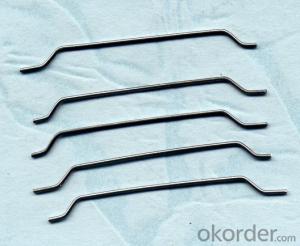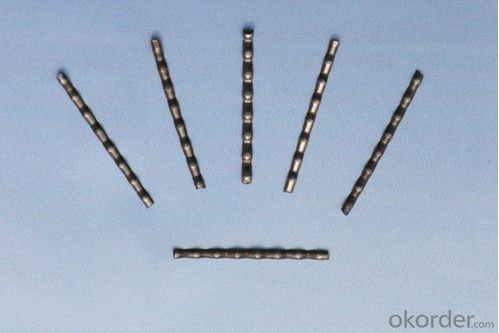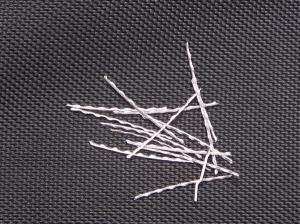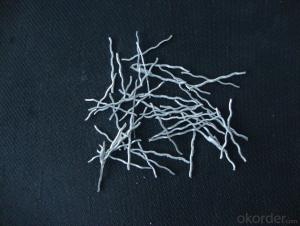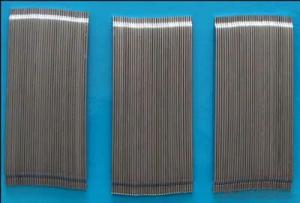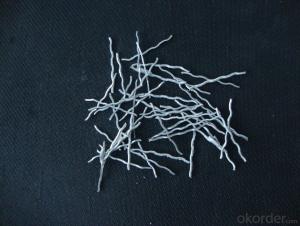Melt Extract Stainless Steel Fiber Reinforced Concrete Admixtures for Cement Composites
- Loading Port:
- Tianjin
- Payment Terms:
- TT OR LC
- Min Order Qty:
- 5 kg
- Supply Capability:
- 250000 kg/month
OKorder Service Pledge
OKorder Financial Service
You Might Also Like
Quick Details
Place of Origin: Hebei, China (Mainland)
Model Number: CW04
Material: Steel
Material:: Steel,low carbon steel wire
Standard:: ASTM ,ISO9001,CE
Shape:: hooked ends and straight middle
Grade:: Q195
Application:: shortcrete on tunnel, underground project, dam plate
Tensile strength:: 1100MPA to 2850Mpa
Demension:: per your requirement
Place of Origin:: HeBei China (Mainland)
Delivery Detail:: in 7 days upon receive prepayment
Product features
with excellent tensile ,hightenacity ,against cracking and fatigue ,they`re widely usd in the structures made of concrete
Specifications
Steel fiber for Concrete Reinforcement
1.High tensile strength 2.Length 6-60mm 3.Diameter 0.2-1.0mm
Steel fiber for Concrete Reinforcement
1.High tensile strength
2.Length 6-60mm
3.Diameter 0.2-1.0mm
4.ISO9001, CE, TUV
Specification | Diameter (mm) | Length (mm) | Aspect ratio (L/D) | Tensile strength (Mpa) |
0.12/6 | 0.12 | 6 | 50 | 2500 |
0.2/6 | 0.2 | 6 | 30 | 2500 |
0.2/13 | 0.2 | 13 | 65 | 2500 |
0.3/25 | 0.3 | 25 | 83 | 2500 |
0.4/25 | 0.4 | 25 | 63 | 1200 |
0.4/30 | 0.4 | 30 | 75 | 1200 |
0.5/30 | 0.5 | 30 | 60 | 1100 |
0.5/25 | 0.5 | 25 | 50 | 1100 |
0.55/25 | 0.55 | 25 | 45 | 800 or 1000 |
0.6/30 | 0.6 | 30 | 50 | 1000 or 1100 |
0.7/30 | 0.7 | 30 | 43 | 1000 |
0.7/35 | 0.7 | 35 | 50 | 1000 |
0.75/35 | 0.75 | 35 | 47 | 1000 |
0.75/60 | 0.75 | 60 | 80 | 1000 |
0.8/60 | 0.8 | 60 | 75 | 1000 |
0.9/50 | 0.9 | 50 | 56 | 1000 |
0.9/60 | 0.9 | 60 | 67 | 1000 |
1.0/50 | 1.0 | 50 | 50 | 1000 |
1.0/60 | 1.0 | 60 | 60 | 1000 |
Picture
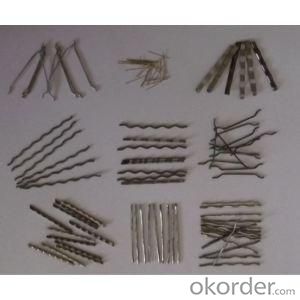
steel fiber concrete reinforced

any type steel fiber

FAQ
we can produce any type steel fiber and of course we can make production according to your requirement
we have specilize in this field for almost 10 years ,with good quality and competitive price
fiber cement,fiber composite
- Q: Can melt extract stainless steel fiber be used in precast concrete products?
- Yes, melt extract stainless steel fiber can be used in precast concrete products. It enhances the strength, durability, and crack resistance of the concrete, making it a suitable choice for precast applications.
- Q: What is the effect of melt extract stainless steel fiber on the fatigue life of asphalt mixtures?
- The use of melt extract stainless steel fiber in asphalt mixtures has a positive effect on the fatigue life of the material. These fibers are added to asphalt mixtures to improve their mechanical properties and enhance their performance under repeated loading conditions. The addition of stainless steel fibers in asphalt mixtures helps to increase the resistance to fatigue cracking. Fatigue cracking is a common distress in asphalt pavements, especially in high-traffic areas, where repeated loading from vehicles can cause the material to weaken and eventually crack. By incorporating stainless steel fibers, the asphalt mixture becomes more resilient and can withstand higher levels of stress without developing cracks. The stainless steel fibers act as reinforcement within the asphalt matrix, providing additional strength and improving the cohesion of the material. This reinforcement helps to distribute the load more evenly across the pavement, reducing the concentration of stress in specific areas and minimizing the formation of fatigue cracks. Furthermore, the presence of stainless steel fibers in the asphalt mixture also improves its resistance to permanent deformation or rutting. Rutting occurs when the asphalt material deforms and becomes permanently displaced under the repeated traffic loads. The fibers help to stabilize the asphalt matrix, preventing excessive deformation and maintaining the integrity of the pavement structure. Overall, the addition of melt extract stainless steel fibers in asphalt mixtures significantly enhances the fatigue life of the material. It improves its resistance to fatigue cracking and rutting, leading to longer-lasting and more durable asphalt pavements. This can result in reduced maintenance and repair costs, as well as improved safety and comfort for road users.
- Q: Can melt extract stainless steel fiber be used in high-performance shotcrete mixtures?
- Yes, melt extract stainless steel fiber can be used in high-performance shotcrete mixtures. The addition of stainless steel fibers enhances the strength, durability, and crack resistance of the shotcrete, making it suitable for demanding applications where high performance is required.
- Q: Can melt extract stainless steel fiber be used in tunnel boring machine applications?
- Indeed, tunnel boring machine applications can incorporate melt extract stainless steel fiber. Renowned for their impressive strength and resistance to corrosion, stainless steel fibers prove ideal for deployment in challenging surroundings like tunneling. By fortifying the concrete utilized in tunnel construction, these fibers enhance its mechanical attributes and durability holistically. Moreover, they bolster the concrete's ability to withstand cracks, thereby diminishing the potential for structural collapse. Consequently, employing melt extract stainless steel fiber in tunnel boring machine applications serves to heighten the longevity and safety of tunnel structures.
- Q: Is melt extract stainless steel fiber compatible with various types of cement?
- Yes, melt extract stainless steel fiber is compatible with various types of cement. These fibers are specifically designed to enhance the performance of cement-based materials, including concrete. They provide reinforcement, improve durability, increase crack resistance, and enhance the overall strength of the cementitious matrix. Melt extract stainless steel fibers have excellent chemical resistance, which allows them to maintain their integrity and effectiveness when exposed to different types of cement and other aggressive substances. Therefore, whether it is Portland cement, fly ash cement, or any other type of cement, melt extract stainless steel fibers can be successfully used to enhance its properties and performance.
- Q: What is the impact of melt extract stainless steel fiber on the thermal properties of concrete?
- The thermal properties of concrete are greatly impacted by the presence of melt extract stainless steel fiber. To enhance the concrete's thermal conductivity and heat resistance, stainless steel fibers are incorporated into the concrete mixture. These fibers serve as conduits for heat within the concrete structure, enabling better heat transfer throughout the entire building. By adding stainless steel fibers, the thermal conductivity of concrete is increased, resulting in more efficient heat transfer within the material. This is particularly advantageous in situations where effective heat dissipation is crucial, such as in the construction of high-temperature industrial facilities or fire-resistant structures. Additionally, the inclusion of stainless steel fibers helps mitigate the risk of thermal cracking in concrete. When exposed to high temperatures, concrete undergoes thermal expansion, which can lead to the formation of cracks. However, by incorporating stainless steel fibers, the heat is distributed more evenly throughout the concrete, reducing the likelihood of localized thermal stresses and consequent cracking. Moreover, stainless steel fibers contribute to enhancing the fire resistance of concrete. By reinforcing the concrete and preventing the propagation of cracks and spalling caused by thermal shock during a fire, the addition of these fibers improves the overall fire rating of concrete structures. In conclusion, the incorporation of melt extract stainless steel fibers in concrete has a significant impact on its thermal properties. It enhances thermal conductivity, reduces the risk of thermal cracking, and increases fire resistance. These advantages make stainless steel fiber-reinforced concrete the preferred choice for applications where thermal performance and resistance to high temperatures are of utmost importance.
- Q: How does the fiber length affect the performance of melt extract stainless steel fiber in concrete?
- The fiber length of melt extract stainless steel fibers has a significant impact on the performance of these fibers in concrete. Longer fiber lengths generally result in improved mechanical properties and performance of the concrete. Firstly, longer fiber lengths provide a greater surface area for bonding with the concrete matrix. This enhanced bond improves the overall strength and load-bearing capacity of the concrete, making it more resistant to cracking and deformation. Additionally, the increased interfacial bond between the fibers and the concrete matrix enhances the fiber's ability to distribute and transfer stresses, resulting in improved durability and increased resistance to impact and fatigue. Moreover, longer fibers also enhance the crack-bridging ability of the concrete. When cracks form in the concrete, longer fibers are more capable of spanning the cracks and preventing their propagation. This crack-bridging ability helps to maintain the integrity of the concrete structure and prevents the cracks from widening, reducing the potential for further damage. Furthermore, longer fibers also improve the post-crack behavior of the concrete. As cracks propagate, the longer fibers can redistribute the stresses and prevent localized failure, resulting in increased ductility. This ductility allows the concrete to undergo greater deformation before failure, enhancing its ability to withstand dynamic loads and sudden impacts. However, it is important to note that there is an optimum fiber length for achieving these desired performance characteristics. Very long fibers may lead to entanglement and clustering, which can negatively affect the workability of the concrete mix and result in an uneven distribution of fibers. On the other hand, very short fibers may not provide sufficient reinforcement to the concrete and may not effectively bridge cracks. In conclusion, the fiber length of melt extract stainless steel fibers plays a crucial role in determining their performance in concrete. Longer fiber lengths generally lead to improved mechanical properties, enhanced crack-bridging ability, and increased post-crack behavior. However, finding the optimal fiber length is essential to achieve the desired properties without compromising other aspects of the concrete mix.
- Q: How does melt extract stainless steel fiber affect the permeability of concrete?
- The permeability of concrete is significantly affected by the inclusion of melt extract stainless steel fibers. These fibers, which are slender and elongated strands, are incorporated into concrete mixtures during the mixing process. Once evenly distributed throughout the concrete, they form a three-dimensional network that enhances the overall strength and durability of the material. One of the primary advantages of using stainless steel fibers is the reduction in concrete permeability. Concrete is naturally a porous substance, allowing the passage of liquids and gases. However, the addition of stainless steel fibers helps to seal these pores and decrease the permeability of the concrete. The melt extract stainless steel fibers serve as a physical barrier, preventing the infiltration of water, chemicals, and other harmful substances into the concrete. This is particularly crucial in environments where the concrete is exposed to harsh conditions, such as marine or industrial settings. By reducing the permeability of concrete, the inclusion of stainless steel fibers also enhances its resistance to corrosion and deterioration. These fibers help to limit the penetration of moisture and aggressive agents that can cause the reinforcement steel within the concrete to rust. Consequently, the lifespan of the concrete structure is prolonged, and maintenance expenses are minimized. Moreover, the decreased permeability of concrete with stainless steel fibers also improves its ability to withstand freeze-thaw cycles. When water enters the concrete and freezes, it expands, generating internal pressure and leading to cracks and deterioration. The presence of stainless steel fibers restricts the entry of water, thus reducing the potential for freeze-thaw damage. In conclusion, melt extract stainless steel fibers have a positive impact on the permeability of concrete. They diminish the flow of water and other harmful substances, improving the durability, resistance to corrosion, and ability to withstand freeze-thaw cycles of the concrete. By enhancing these properties, stainless steel fibers contribute to the overall performance and longevity of concrete structures.
- Q: What is the thermal conductivity of melt extract stainless steel fiber?
- The thermal conductivity of melt extract stainless steel fiber can vary depending on various factors such as the composition of the stainless steel alloy, the manufacturing process, and the specific application. However, stainless steel is generally known for its relatively low thermal conductivity compared to other metals. Stainless steel fibers are typically used as reinforcement in various composite materials, including high-temperature insulation, concrete, and plastics. These fibers can enhance the mechanical properties and thermal stability of the composites. In terms of thermal conductivity, stainless steel fibers provide a moderate level of heat transfer resistance. While they are not as efficient as insulating materials like ceramics or polymers, stainless steel fibers still offer better thermal conductivity compared to solid stainless steel. This is due to the smaller cross-sectional area of the fibers, which reduces the direct conduction of heat. It is worth noting that the thermal conductivity of melt extract stainless steel fiber can be further influenced by factors such as fiber diameter, aspect ratio, packing density, and temperature. Therefore, it is crucial to consider these variables when evaluating the thermal conductivity of stainless steel fiber in a specific application.
- Q: Can melt extract stainless steel fiber be used in tunnel segments?
- Yes, melt extract stainless steel fiber can be used in tunnel segments. Stainless steel fibers are commonly added to concrete mixtures to enhance the mechanical properties of the material and improve its durability. In tunnel construction, the use of stainless steel fibers can help to increase the strength and resistance to cracking of the concrete segments, reducing the risk of structural failures. Additionally, stainless steel fibers can also provide enhanced resistance to corrosion, making them suitable for tunnel segments that may be exposed to moisture or aggressive environments. Therefore, melt extract stainless steel fiber can be effectively used in tunnel segments to improve their structural integrity and longevity.
Send your message to us
Melt Extract Stainless Steel Fiber Reinforced Concrete Admixtures for Cement Composites
- Loading Port:
- Tianjin
- Payment Terms:
- TT OR LC
- Min Order Qty:
- 5 kg
- Supply Capability:
- 250000 kg/month
OKorder Service Pledge
OKorder Financial Service
Similar products
Hot products
Hot Searches
Related keywords


